on Porsche, Magna Battery Enclosures, New Nissan Z, Volvo C40 Recharge
Porsche quickly develops EV prototype for racing. . . Magna has big growth in battery enclosures. . . the new Nissan Z. . . diesels in Europe. . .Volvo C40 Recharge driven. . .
Porsche’s Quick Car: Development Time, Too

In September 2021 Porsche showed the MIssion R, an EV concept. Since then there has been a transformation into the 718 Cayman GT4 ePerformance, a working prototype. (Image: Porsche)
Porsche, at the 2021 IAA MOBILITY in Munich last September, displayed a fully electric GT concept car, the Mission R.
And now, eight months later, Porsche has the 718 Cayman GT4 ePerformance, a prototype, based on that concept. It is track-capable.
Yes, the vehicle is based on the chassis of the existing 718 GT4 Clubsport model. But approximately 6,000 parts were designed from scratch for the EV, which is 14 cm (5.5 inches) wider than the donor vehicle.
The car uses two oil-cooled permanently excited synchronous machines, one on each axle. Consequently it is all-wheel drive. The motors can provide a peak output of 800 kW (1,073 hp).
It has been determined the race car can run at 603 hp for 30 minutes.
Thirty minutes? That’s the time of a Carrera Cup race
Convenient.
///
Magna Using What It Knows to Build Battery Enclosures
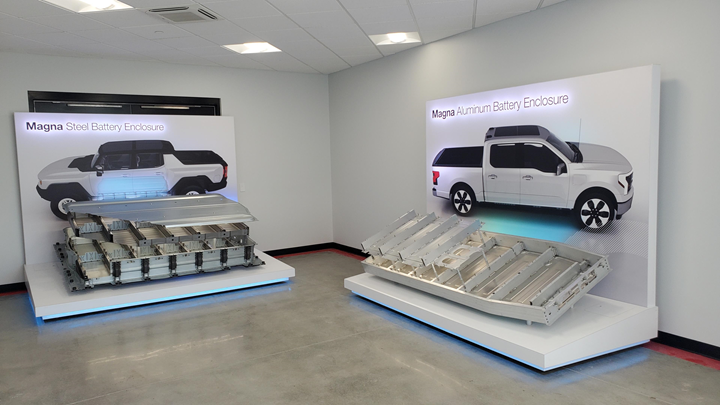
Magna is producing the battery enclosures for the HUMMER EV and the F-150 Lightning, steel for the former and aluminum for the latter. (Image: Magna)
Two of the most talked-about EVs right now are the Ford F-150 Lightning and the GMC HUMMER EV.
The batteries for the Lightning are sourced from SK Innovation.
The batteries for the HUMMER EV come from LG Energy Solution.
The enclosure for the Lightning battery is made with aluminum.
The enclosure for the HUMMER EV battery is made with steel.
And both of those enclosures are made by Magna.
Swamy Kotagiri, Magna CEO, describes the battery enclosures as “large, high-content, highly engineered” products.
What’s more, he says that the market for the enclosures is showing sharp growth, with the company projecting that by 2027 sales could be on the order of >$1.5-billion.
And for Magna, that started in 2021 at a minor fraction of that. Clearly there is dynamic growth in the EV space, which savvy suppliers are addressing.
Using what they know
Kotagiri says producing battery enclosures takes advantage of existing Magna capabilities, such as stamping, extrusion, welding (including spot and laser), fastening, sealing, leak testing, and more.
He also points out that Magna is “material agnostic,” which goes to the aluminum and steel enclosures that it is currently producing.
Kotagiri says that to handle the increasing demand for battery enclosures, Magna is investing $500 million in manufacturing over the next three years.
(It is worth noting that Magna has “significant content”—it is also producing various electric drive systems and other components—on EVs including the aforementioned Lightning and HUMMER as well as on the Fisker Ocean; Mercedes-Benz GLS and EQE; NIO ES7; Cadillac LYRIQ; Rivian R1S; Xpeng G9; Volkswagen ID Buzz; Smart B-SUV.)
///
2023 Nissan Z Launched
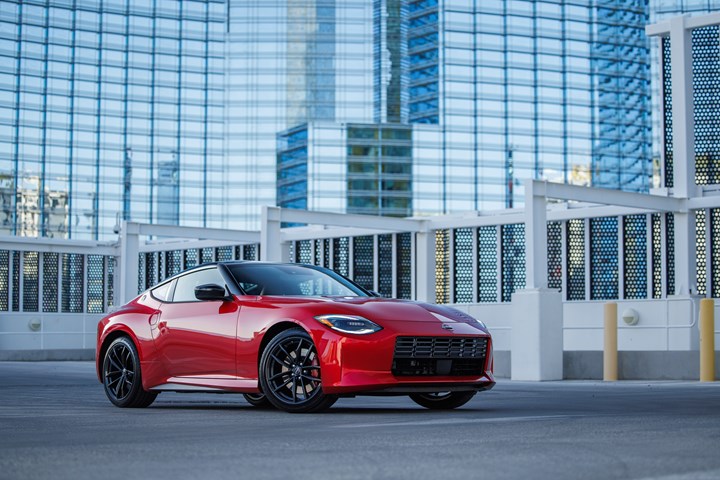
The 2023 Nissan Z. Comparatively affordable. And quick. (Image: Nissan)
In 1964 the Academy Award-winning musical My Fair Lady was released.
Which seems like an usual way to start something in a space not devoted to films, musicals, or the work of Audrey Hepburn.
But Hiroshi Tamura, who is with Product Planning at Nissan Motor Company Limited (the main company), notes that the original Nissan Z, the S30, which went into production in October 1969 as a 1970 model year vehicle and carried the 240Z moniker in the U.S. market, was known in Japan as the “Fairlady Z.
Yes, “Fairlady” as in Eliza Doolittle. It was meant to signify beauty and something aspirational.
The “Z” stood for limitless possibilities and dreams.
And with a little bit of luck you may find the 2023 Z, the seventh generation, on the street where you live.*
How it came to be
Let’s face it: Nissan has been struggling in the market for the past few years (although lately back in the black). Somehow a sports car doesn’t seem to be the sort of thing that a company might invest its resources on while being in trying financial conditions.
In the Z’s 53-year history it has garnered 1.8-million units of sales on a global basis. The average number of vehicles sold in a given year (and let’s face it, sales of any vehicle aren’t at all consistent) would be 34,000.
Not exactly a banner number.
There were probably some people at Nissan HQ with sharp pencils who thought the sixth version, the 370Z, was enough.
And let’s not forget the monies that need to be spent on developing electric vehicles. Nissan is coming out with the Nissan Ariya this year, its first all-electric crossover. Presumably this took considerable resources.
But Tamura points out that in March of 2017 he made a presentation to management about a seventh-gen Z. It wasn’t an elaborate PowerPoint. It was a memo that he originally scratched out on paper.
It was acknowledged that the Z represents something of the spirit of the company. It was a value Nissan leaders didn’t want to give up.
Who wants to throw out limitless possibilities and dreams?
Tamura got the green light.
There were, however, a couple of things that they had to do:
- Maintain the style of the Z
- Make it attainable
So for 1. . .
Tamura says there were 414 sketches for the Z generated by designers from around the world, whereas the number is usually on the order of 70 to 80. Clearly, this is a project with a whole lot of desirability for the Nissan team.
Although the Z (they’ve dropped the numeric nomenclature, so it is now just “Z,” although there are two variants, the Sport and the Performance, and while there is a third, Proto Spec, only 240 of that version are going to be built, so that really doesn’t count) looks contemporary, there are still the long hood and short decklid that makes it unmistakable as to where it came from.
As for 2. . .
The starting MSRP for the Z Sport—whether the six-speed manual or nine-speed automatic is selected—is $39,990. The Z Performance starts at $49,990. (And for that handful of Proto Specs: $52,990.)
Learnings applied
Nissan has another performance car in the market right now, the 565-hp GT-R.
Tamura says that the team that developed the GT-R were part of the Z team. One area that they helped focus on is the aero of the coupe. So for the Z Performance, which has front and rear spoilers, the GT-R learnings result in a 63% reduction in front lift and ~60% reduction in rear lift compared to the Sport version, which lacks these spoilers.
Material choices
One of the things that is absolutely essential in a rear sports coupe—especially one a twin-turbo V6 that produces 400 hp and 350 lb-ft of torque that pretty much has as its reason for being to be driven hard on roads that aren’t straight—is that it feel rigid.
Tamura says that compared to the 370Z, there is a 10.8% increase in torsional stiffness and 23.9% increase in body rigidity. He explains that the improvements to the body-in-white are largely predicated on the use of additional bracing. He also notes that the structure is steel-intensive so as to keep the vehicle’s price under control.
However, aluminum is used throughout the suspension as well as for the hood, doors and rear hatch. What’s more, the vehicles with the manual transmission have a carbon fiber drive shaft., and the transmission case for the automatic is magnesium.
Observations
I had the opportunity to take a Z Performance out on the freeways and through some of the twisty roads in Livingston County, Michigan, that are favorites of auto buff book writers and NACTOY jurors.
One of the things that is common on Michigan roads of any type is the pickup truck. In addition to which, the full-size ute.
So being in a car that is 51.8 inches high could cause one to feel vulnerable. Yet I found that the responsiveness of the Z was such that that was not an issue: if there were Big Vehicles on either side, a judicious use of the accelerator put me in open spaces, pronto.
As for the curved roads, the vehicle felt planted and the electronic power steering did its job with aplomb.
This is a modern vehicle, with all the obligatory stuff, from intelligent cruise to rear cross traffic alert (useful in a car that is diminutive), a 9-inch touchscreen and Bose audio (on the Performance version) to Apple CarPlay and Android Auto.
While it is imminently drivable, it is probably a second car, not a primary. And it will probably be most appealing to all of those who couldn’t afford a 300Z or 350Z back in the day and now have the means to really enjoy it.
==
*If they could name a car after the musical, I can use appropriate puns.
///
Vehicle Sales Down, Gas Prices Up—But There Is Something Surprising
Michael Sivak of Sivak Applied Research has compiled some interesting numbers that show what the state of prices for vehicles and the fuel to power them have been.
So, looking at the past six months:
- November 21: light-duty vehicles -28%, gas +21%
- December 21: LDVs -21%, gas +19%.
- January 22: LDVs -13%, gas +32%
- February 22: LDVs -17%, gas +36%
- March 22: LDVs -22%, gas +48%
- April 22: LDVs -8%, gas +30%
In terms of vehicle sales, that run of minus signs is not good news for consumers. Availability and affordability are both challenges.
The fuel price rises are of most interest. Although newscasts—national, local—are are reporting on record-high gas prices lately, it is evident from Sivak’s numbers that this shouldn’t have taken anyone by surprise because that walk-up in prices has happened over the past several months.
Perhaps the reduced number of vehicle sales isn’t all that bad for consumers: Imagine what the demand for gas would be if this was a “normal” period.
///
Quick Diesel Quiz
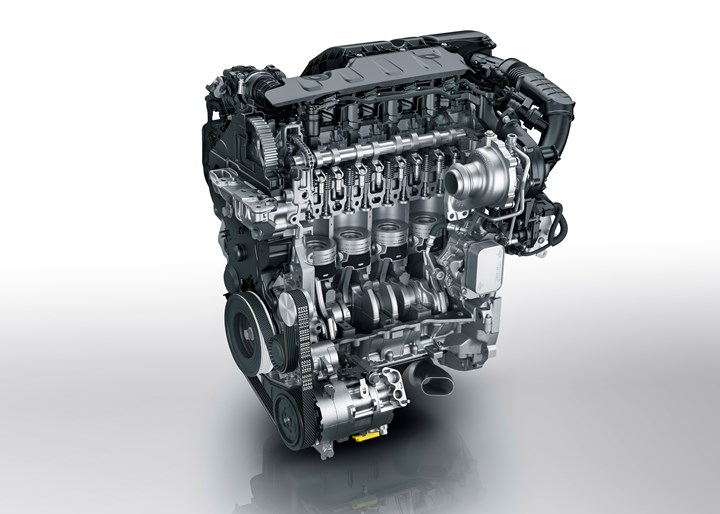
Opel Grandland 1.5-liter diesel (Image: Opel)
In April 2022, what was the diesel share of new car sales in western Europe:
- 7%
- 12.5%
- 15%
- 19.5%
- 20%
- 21.5%
- 23%
The answer, according to LMC Automotive: 19.5%.
LMC’s analysis has it:
“April’s diesel figure continued the (unusual) theme of resilience in the region’s diesel car market this year as the trend to plug‐in electrification has slowed partly due to less focus on tougher CO2 targets but also due to price increases starting to seep through to BEV buyers in particular.”
Seems like some practical issues are coming to the fore (e.g., people have always said that diesel vehicles are expensive, which is true compared to comparable gasoline-powered cars—but many EVs make diesels seem like the prudent financial choice).
What’s more, LMC adds:
“Several OEMs have made the point recently that combustion engines (including diesel) will continue to have a part to play in the region’s future powertrain mix with the likely looming shortage of battery materials for BEVs bringing this into sharp focus.”
Remember: These are European OEMs.
That needs to be underscored because according to the IEA, in 2021 electric vehicle sales (including hybrids) in Europe grew 70%, to 2.3 million vehicles, so the strength of diesels is surprising.
In 2021 the comparable sales of electrified vehicles in the U.S. were 0.7-million.
This is not to imply that there will be an increase in the number of light vehicles in the U.S. with diesels.
Even if there were, there would be a long way to go to get to 19.5% because according to Statista, in 2021 diesels had 0.34% of the U.S. market
///
2022 Volvo C40 Recharge Twin Ultimate
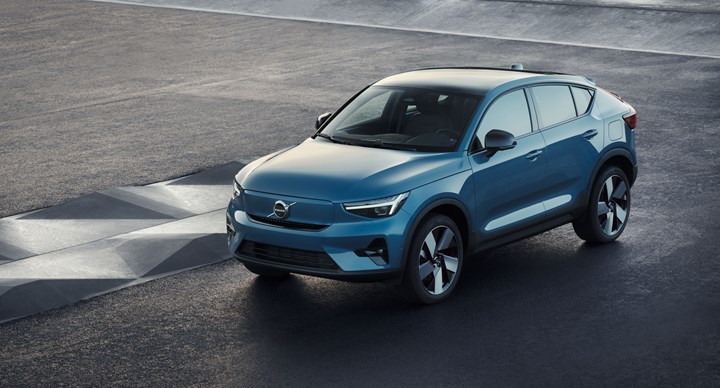
The Volvo C40 Recharge. One thing to get used to in this EV: When you get in to drive, as long as you have the fob on you, it is a matter of simply selecting Drive or Reverse and you’re on your way. Not even the push of a button is required. (Image: Volvo)
First, something you may not be familiar with
Most automotive vehicles are brought to a stop when the brakes are applied through friction: brake pads applied to discs or drums.
Electrified vehicles also use a method called “regenerative braking.” It uses a motor that runs in reverse to slow the vehicle. And as in that arrangement it acts as a generator; it also serves to put electricity into the vehicle’s battery.
While hybrids and EVs both have regenerative braking capabilities, it is in EVs where it is most apparent.
Done with one
In fact, regenerative braking in EVs can be so powerful that there is the possibility of what’s known as “one-pedal driving.”
This is as it sounds: The forward motion of the vehicle can be controlled (fully or in large part) through the accelerator pedal alone. When the driver lifts from the pedal the regeneration kicks in to the extent that it can stop the vehicle, depending, of course, on how fast the vehicle is traveling. It may be that the stopping distance would be too great just depending on the generator alone, at which point the mechanical brakes kick in, too. But in many driving situations, using just one pedal works fine.
However, this takes some getting used to because the vehicle “feels” different.
This is what I discovered when driving the Volvo C40 Recharge Twin Ultimate.
You choose
This is a vehicle that produces 402 hp and 486 lb-ft of torque. (The “Twin” in the name means that there are two electric motors, one on each axle, 201 hp each.) The sort of thing that, especially as it is an EV, should exhibit really responsive get-up-and-go. Yet when I first started out, it seemed a bit heavy.
When back in my driveway I scrolled through the settings on the 9-inch touchscreen and found that I could switch off the one-pedal driving. (OK: I used the digital driver’s manual to find that. The digital manual is quite handy compared with flipping through pages.)
The acceleration experience was then what I had expected that it would be for this compact luxury crossover.
If you are someone who is going to want to eek out all possible range from the vehicle that has a 78-kWh lithium-ion battery you are going to keep that on-pedal function activated. With an EPA-estimated range of 226 miles, it very well may be that it could be a wise choice.
But let’s face it: when you are driving a well-appointed vehicle with a base MSRP of $58,750, you probably aren’t all that concerned about thriftiness. (It is worth noting that part of the price of the vehicle includes 250 kW of DC fast charging through Electrify America.)
Different materials
Speaking of the appointments, it is worth noting that Volvo is in the process of ending the use of leather in its vehicles, and as such the C40 Recharge interior uses sustainable materials that are produced from bio-based and recycled materials. Don’t think that this is in anyway some sort of penance that you’re going to endure; the materials in the car (e.g., the door trim isn’t a shiny plastic that you’re familiar with, but a felt-like fabric) are different. Nicely different. The vinyl, for example, is a material called “Microtech,” which started out as things like water bottles.
Simple. Stylish. Sustainable.
Just Google that destination
The C40 Recharge includes Google Automotive Services, so if you’re an Android partisan you’re in great shape as there are Google Maps, Google Assistant and. . .the Google Play Store.
One thing I don’t care for regarding the interior is the “Panoramic Laminated Fixed Glass Roof with Dark Tint & IR Coating for UV Protection” (as described on the Monroney). There is no shade. Just the glass roof. I fail to understand the point.
But that’s just me.
A point
Volvo is in the process of building out its vehicle portfolio such that by 2030 it will offer only fully electric cars.
The C40 Recharge is a good element in that strategy.
///
Erratum
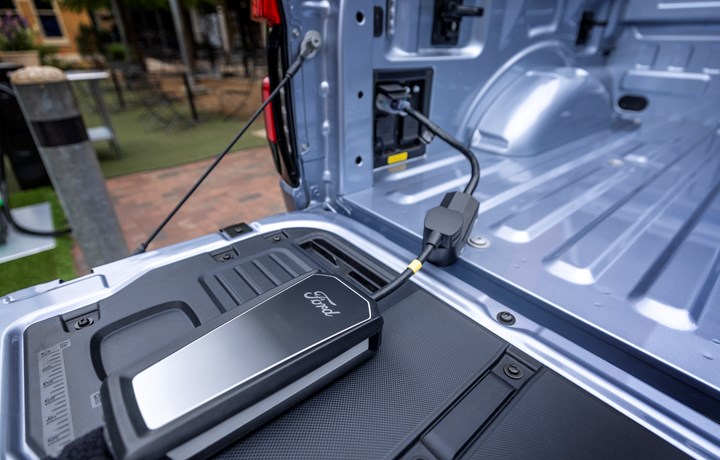
(Image: Ford)
For those of you who read this in the LinkedIn on email versions last week, please know that the outlets in the F-150 Lightning with the Pro Power Onboard system are 120-V, with a 240-Volt outlet in the bed, too. Those of you who are reading this on line, never mind.
(My thanks to Dr. Dave Tuttle, a Research Associate in the Energy Institute at University of Texas at Austin, for pointing this out to me.)
RELATED CONTENT
-
Increasing Use of Structural Adhesives in Automotive
Can you glue a car together? Frank Billotto of DuPont Transportation & Industrial discusses the major role structural adhesives can play in vehicle assembly.
-
On Fuel Cells, Battery Enclosures, and Lucid Air
A skateboard for fuel cells, building a better battery enclosure, what ADAS does, a big engine for boats, the curious case of lean production, what drivers think, and why Lucid is remarkable
-
Things to Know About Cam Grinding
By James Gaffney, Product Engineer, Precision Grinding and Patrick D. Redington, Manager, Precision Grinding Business Unit, Norton Company (Worcester, MA)


.jpg;width=70;height=70;mode=crop)






